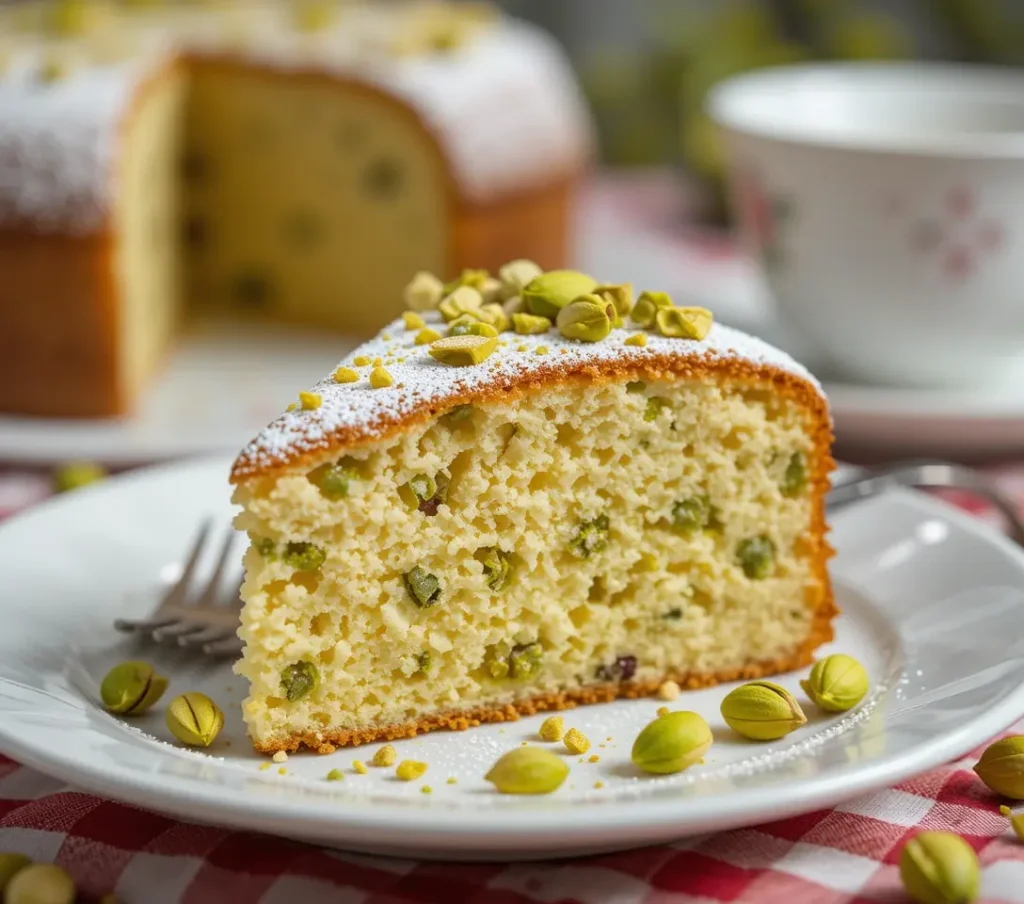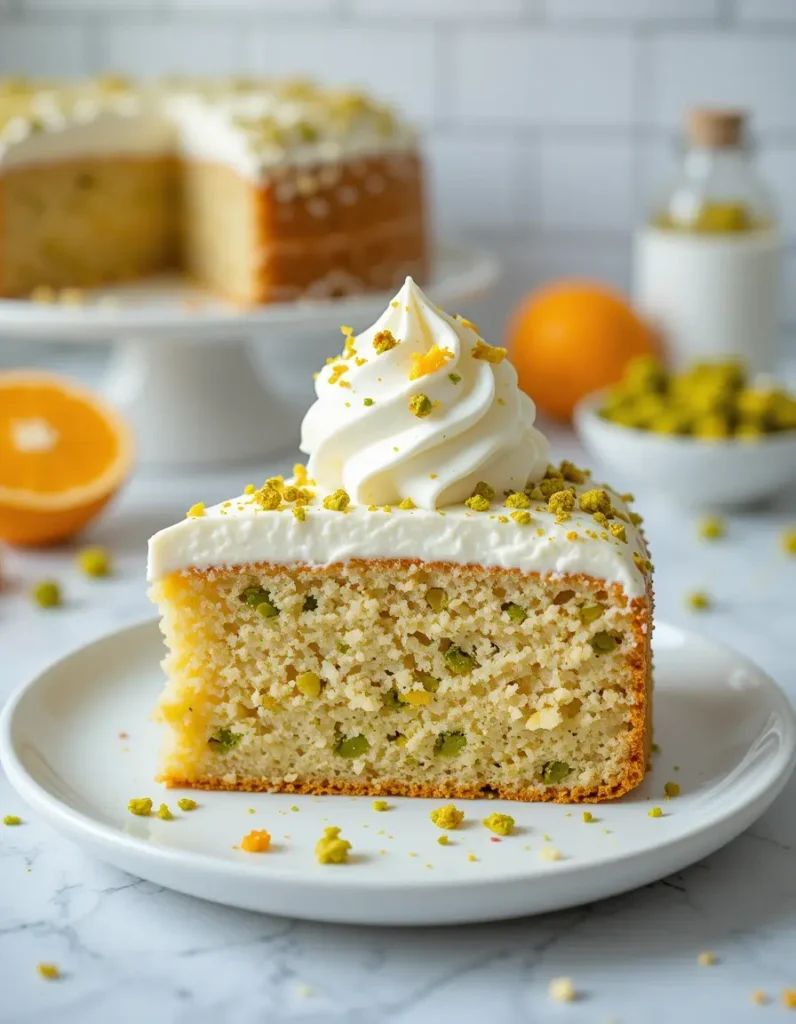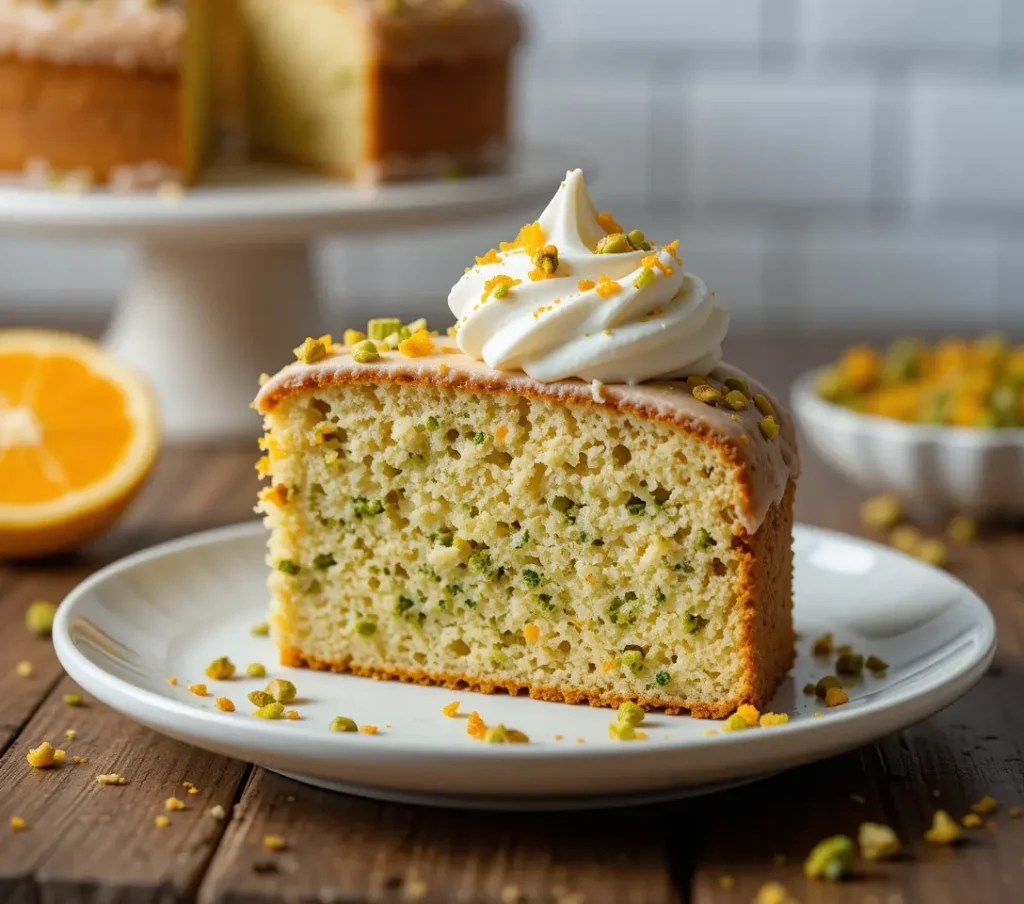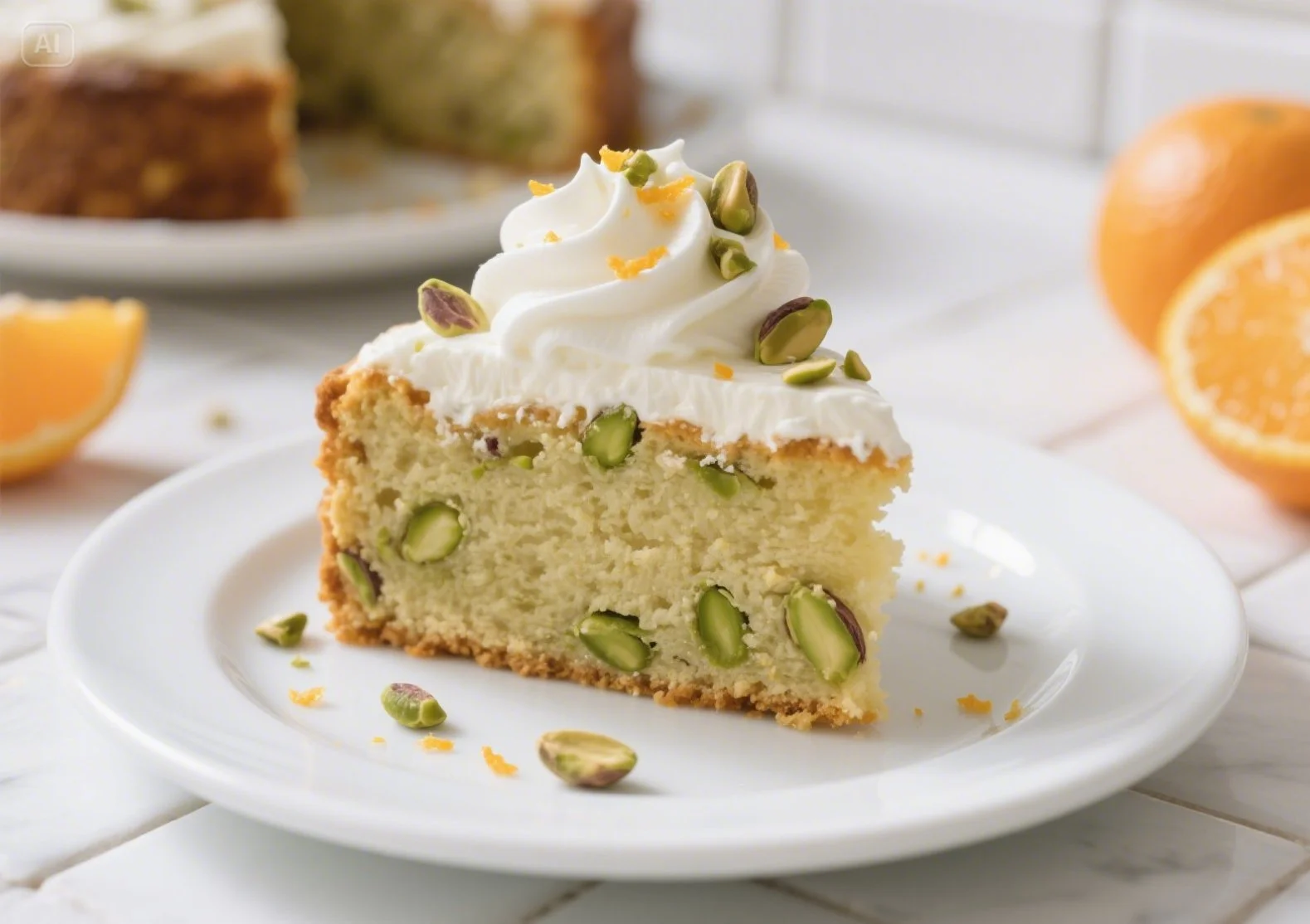Introduction
Picture a cake so tender it melts on your tongue, with a delicate nutty aroma and a crumb so moist it feels almost luxurious. This is the magic of Pistachio Ricotta Cake, a dessert that effortlessly balances simplicity and sophistication. Born from the heart of Italian baking traditions, this cake combines creamy ricotta cheese and earthy pistachios in a way that feels both timeless and refreshingly modern.
What sets this cake apart? It’s not just the rich, nutty flavor or the cloud-like texture (though those alone are reason enough to try it). The secret lies in the harmony of its two star ingredients: ricotta cheese adds a subtle tang and unparalleled moisture, while pistachios infuse every bite with a buttery, slightly sweet depth. Together, they create a dessert that’s rustic enough for a weeknight treat yet elegant enough to crown a holiday table.
Rooted in Italy’s love for wholesome, ingredient-driven desserts, this Pistachio Ricotta Cake skips fussy techniques and complicated steps. You won’t need a mixer or specialty tools, just a handful of pantry staples and about 10 minutes of active prep. Whether you’re a baking novice or a seasoned pro, this recipe delivers consistent results: a golden, crackly crust giving way to a soft, almost pudding-like interior.
By the end of this guide, you’ll see why this cake has become a staple in kitchens worldwide. It’s forgiving, versatile, and guaranteed to earn compliments. Let’s dive into the details so you can experience this easy, Italian-inspired dessert for yourself.
Key Highlights:
- Effortless elegance: No advanced skills required.
- Italian heritage: A nod to classic ricotta-based desserts like torta della nonna.
- Texture contrast: Crisp edges vs. velvety crumb.
- Pantry-friendly: Uses everyday ingredients with minimal prep.
Ready to bake? Let’s get started.
What Makes This Pistachio Ricotta Cake Special?

At first glance, this cake seems almost too good to be true: a dessert that’s both decadent and light, richly flavored yet balanced, and stunning without requiring hours of work. Let’s break down what sets it apart.
1. Ricotta Cheese: The Secret to Moisture & Creaminess
Ricotta cheese isn’t just a filling for lasagna, it’s a baking powerhouse. Unlike heavier creams or oils, ricotta adds moisture and a creamy texture without weighing down the cake. Its mild tanginess balances the sweetness, while its high water content keeps every bite tender. Think of it as the invisible hero that ensures your cake stays soft, even days after baking.
2. Pistachios: Nutty Flavor Meets Subtle Crunch
Pistachios do double duty here. Finely ground into the batter, they lend a nutty flavor that’s earthy and slightly sweet, complementing the ricotta perfectly. A handful of chopped pistachios sprinkled on top before baking adds a delicate crunch, creating a playful contrast to the cake’s velvety crumb.
3. Balanced Sweetness & Fragrant Notes
This isn’t a sugar bomb. The sweetness is subtle, letting the pistachios and ricotta shine. A touch of lemon zest brightens the richness, while vanilla adds warmth. Together, they create a delicate flavor profile that feels refined without being pretentious.
4. Simple Enough for Any Home Baker
No stand mixer? No problem. This recipe skips complicated steps. You’ll mix the batter by hand, fold in the ingredients gently, and bake. The result? A homemade cake that looks and tastes like it came from a boutique bakery.
Why You’ll Love It:
- Creamy texture from ricotta keeps every slice irresistibly moist.
- The nutty flavor of pistachios feels gourmet, not overwhelming.
- Bright, fragrant notes from lemon and vanilla elevate simplicity.
- Effortless process no fancy tools or advanced skills needed.
This cake proves that extraordinary desserts don’t require extraordinary effort. Whether you’re baking for a special occasion or a quiet Tuesday, it’s a recipe that delivers joy in every bite.
Key Ingredients You’ll Need

Here’s everything required to make this Pistachio Ricotta Cake. Stick to quality ingredients for the best flavor and texture:
Ingredient List
- 1 ½ cups (360g) whole milk ricotta cheese (see notes below)
- 1 cup (120g) shelled unsalted pistachios (or ¼ cup pistachio paste)
- 1 ½ cups (190g) all-purpose flour
- ¾ cup (150g) granulated sugar
- 3 large eggs, room temperature
- ½ cup (115g) unsalted butter, melted and cooled
- 1 ½ tsp baking powder
- 1 tsp vanilla extract
- 1 tbsp Orange zest (optional but recommended)
- ¼ tsp salt
Ingredient Notes
1. Ricotta Cheese: Go for Whole Milk
- Why it matters: Whole milk ricotta has a higher fat content, which translates to a creamier texture and richer flavor. Avoid low-fat versions they can make the cake dry.
- Prep tip: If your ricotta looks watery, drain it in a fine-mesh sieve for 10 minutes to remove excess liquid. This prevents a soggy crumb.
2. Pistachios: Shelled & Unsalted
- Freshness is key: Use raw, shelled pistachios for the brightest flavor. Pre-shelled saves time, but check for freshness (avoid stale or overly dry nuts).
- Toasting optional: For extra depth, toast pistachios in a dry pan for 2–3 minutes before grinding. Let them cool completely.
- Pistachio paste shortcut: Short on time? Substitute ¼ cup store-bought pistachio paste for ground nuts. Note: Paste may alter the cake’s color (darker green).
3. The Supporting Cast
- Flour: All-purpose works best for structure. For gluten-free, swap in 1:1 GF flour.
- Sugar: Granulated sugar balances the ricotta’s tang. Reduce to ½ cup for a less sweet cake.
- Eggs: Room temperature eggs blend smoothly into the batter.
- Butter: Melted butter keeps the crumb tender. Substitute neutral oil (e.g., avocado) for a dairy-free version.
Pro Tip:
Measure flour correctly to avoid a dense cake: Spoon flour into your measuring cup (don’t scoop!), then level with a knife.
With these ingredients prepped, you’re ready to bake! Next up: the step-by-step guide.
Step-by-Step Recipe: How to Make Pistachio Ricotta Cake

Follow these simple steps to create a cake that’s moist, nutty, and utterly irresistible.
1. Prep the Oven & Pan
- Preheat oven to 350°F (175°C).
- Grease a 9-inch springform pan with butter or non-stick spray. For extra insurance, line the bottom with parchment paper.
2. Mix the Wet Ingredients
- In a large bowl, whisk together:
- 1 ½ cups whole milk ricotta cheese
- ¾ cup granulated sugar
- 3 large eggs
- 1 tsp vanilla extract
- ½ cup melted butter
Mix until smooth and fully combined.
3. Combine the Dry Ingredients
- In a separate bowl, sift together:
- 1 ½ cups all-purpose flour
- 1 ½ tsp baking powder
- ¼ tsp salt
- 1 tbsp lemon zest (optional)
4. Blend Wet & Dry Mixtures
- Pour the dry ingredients into the wet mixture. Use a spatula to gently fold until just combined. A few lumps are okay—overmixing leads to a dense cake.
5. Add Pistachios
- Fold in ½ cup chopped pistachios (reserve the rest for topping).
6. Bake the Cake
- Pour batter into the prepared pan. Smooth the top with a spatula.
- Sprinkle remaining pistachios over the batter.
- Bake for 45–50 minutes at 350°F. The cake is done when a toothpick inserted into the center comes out clean, and the edges pull away from the pan.
7. Cool Properly
- Let the cake cool in the pan for 15 minutes on a cooling rack.
- Remove the springform ring and cool completely (1–2 hours). This prevents crumbling when slicing.
8. Serve & Finish
- Dust with powdered sugar before serving for a touch of sweetness.
- Slice with a sharp knife, wiping it clean between cuts for neat portions.
Pro Tips:
- Don’t rush cooling: A warm cake can collapse or tear.
- Test for doneness early: Ovens vary start checking at 40 minutes.
- Boost flavor: Add a drizzle of honey or a dollop of whipped cream.
Up next: the tools you’ll need to make this recipe foolproof.
Equipment You’ll Need
You don’t need fancy gadgets to make this cake just a few basic kitchen tools most bakers already own. Here’s your checklist:
Essential Tools
- 9-inch springform pan: Ensures easy removal and even baking.
- Mixing bowls (2): One for wet ingredients, one for dry.
- Whisk: For blending ricotta, eggs, and sugar smoothly.
- Rubber spatula: Gently folds batter without overmixing.
- Measuring cups and spoons: Precision matters for consistent results.
- Parchment paper (optional): Lines the pan to prevent sticking.
- Cooling rack: Lets air circulate so the cake doesn’t steam.
- Oven thermometer: Verifies accurate baking temperature.
Helpful Extras
- Food processor: Quickly grinds pistachios into fine crumbs. (Skip if using pre-ground nuts or pistachio paste.)
- Fine-mesh sieve: Drains excess liquid from ricotta if needed.
- Zester: Easily removes lemon zest for bright flavor.
Pro Tips:
- No springform pan? Use a regular 9-inch cake pan lined with parchment. Trim the edges after cooling.
- Hand mixer alternative: A sturdy whisk works just mix a bit longer.
- Grinding pistachios: Pulse in a blender if you don’t have a food processor.
With these tools ready, you’re set to bake stress-free. Next up: tips to guarantee a moist, flawless cake every time.
Tips for a Perfectly Moist Pistachio Ricotta Cake
Even the simplest recipes benefit from a few expert tricks. Follow these tips to nail the texture and flavor every time:
1. Start with Well-Prepared Ricotta
- Drain watery ricotta: Place it in a fine-mesh sieve for 10 minutes to remove excess liquid. This prevents a soggy crumb.
- Use full-fat ricotta: Higher fat content = better moisture retention. Low-fat versions can dry out the cake.
2. Mix Gently, Mix Less
- Fold, don’t beat: Overmixing develops gluten, leading to a dense texture. Stir until just combined—a few lumps are fine.
- Use a spatula: It gives you more control than a whisk.
3. Test Doneness Like a Pro
- Toothpick test: Insert it into the center. If it comes out with moist crumbs (not wet batter), it’s done.
- Visual cue: The edges will pull slightly away from the pan.
4. Toast Pistachios for Extra Flavor
- Boost nutty flavor: Lightly toast shelled pistachios in a dry skillet for 2–3 minutes before grinding. Cool completely to avoid greasiness.
5. Add Almond Extract (Optional)
- Complementary flavor: Stir in ½ tsp almond extract with the vanilla. It enhances the pistachios’ natural sweetness without overpowering.
6. Cool Patiently
- In the pan first: Let the cake rest for 15 minutes after baking. This sets the structure.
- Then on a rack: Transfer to a cooling rack to stop carryover cooking. Cutting too soon causes crumbling.
Pro Tips for Success:
- Room-temperature eggs: They blend smoothly into the batter for even texture.
- Measure flour correctly: Spoon it into the cup, don’t scoop! Overpacked flour = dry cake.
- Oven calibration: Use a thermometer. An oven that runs hot can overbake the edges.
With these tips, your cake will have a tender crumb, balanced sweetness, and that signature nutty richness everyone will love. Next up: creative twists and serving ideas!
Variations & Serving Suggestions
This Pistachio Ricotta Cake is a blank canvas for creativity. Here’s how to adapt it to your taste or occasion:
1. Switch Up the Shape
- Loaf cake: Use a 9×5-inch loaf pan. Bake at 350°F for 50–60 minutes.
- Mini cakes: Divide batter into a 12-cup muffin tin. Bake for 20–25 minutes.
2. Boost Flavor & Presentation
- Lemon glaze: Mix 1 cup powdered sugar + 2 tbsp lemon juice. Drizzle over cooled cake.
- Pistachio paste: Replace ground pistachios with ¼ cup paste for bolder color and flavor.
- Chocolate drizzle: Melt dark chocolate with a splash of cream. Swirl over the top.
3. Pair with Complementary Toppings
- Fresh berries: Serve slices with raspberries or strawberries for a tart contrast.
- Whipped cream: Add a dollop of lightly sweetened cream or mascarpone.
- Crunchy garnish: Sprinkle with toasted coconut or crushed amaretti cookies.
4. Make It Occasion-Ready
- Afternoon tea: Slice thinly and pair with Earl Grey or mint tea.
- Coffee cake: Serve slightly warm with a dusting of cinnamon sugar.
- Holiday dessert: Add edible gold flakes or pomegranate seeds for festive flair.
5. Dietary Tweaks
- Gluten-free: Swap all-purpose flour for a 1:1 GF blend.
- Dairy-free: Use plant-based ricotta (e.g., almond or soy) and coconut oil instead of butter.
Pro Tips for Serving:
- Room temperature: Let chilled cake sit for 30 minutes before serving to revive moisture.
- Presentation: Garnish with whole pistachios and mint leaves for a restaurant-worthy finish.
- Pairings: Try with a scoop of lemon sorbet or a cup of cardamom-spiced coffee.
Whether you stick to the classic recipe or experiment with these ideas, this cake adapts to your cravings and calendar. Up next: nutrition details to help you enjoy guilt-free!
Approximate Nutrition Facts
Note: Values below are estimates based on standard ingredients and a 12-slice cake. Actual numbers may vary depending on specific brands, substitutions, or portion sizes.
Per Serving (1 slice):
- Calories: 300–320
- Total Fat: 18g
- Saturated Fat: 6g
- Cholesterol: 80mg
- Sodium: 200mg
- Total Carbohydrates: 30g
- Dietary Fiber: 2g
- Total Sugars: 15g
- Protein: 8g
Key Nutrient Insights:
- Protein boost: Ricotta and pistachios contribute to the cake’s protein content, making it slightly more satiating than typical desserts.
- Natural sugars: About 40% of the sugar comes from ricotta’s lactose and pistachios’ natural sweetness.
- Fiber source: Pistachios add a modest amount of fiber for better digestion.
Important Disclaimer:
This nutritional breakdown is a general guide. For precise tracking, use a calculator like MyFitnessPal with your exact ingredients. Always consult a dietitian for specialized dietary needs.
Next up: How to store leftovers (if there are any!).
How to Store Your Homemade Pistachio Ricotta Cake
Keep your cake tasting fresh and moist for days with these storage guidelines.
1. Cool Completely Before Storing
- Let the cake cool to room temperature on a wire rack (1–2 hours). Trapped heat creates condensation, leading to sogginess.
2. Short-Term Storage (1–2 Days)
- Room temperature: Place the cake in an airtight container or wrap tightly in plastic wrap. Store in a cool, dry spot away from sunlight.
- Best for texture: The cake retains its tender crumb best at room temp.
3. Refrigeration (Up to 5 Days)
- Chill for longer freshness: Wrap the cake in plastic wrap or store in an airtight container.
- Before serving: Let refrigerated slices sit at room temperature for 30 minutes to restore softness.
4. Freezing (Up to 3 Months)
- Whole cake: Wrap tightly in plastic, then aluminum foil.
- Individual slices: Separate slices with parchment paper and store in a freezer-safe bag.
- Thawing: Transfer to the fridge overnight or countertop for 2–3 hours.
Reviving Leftovers
- Refresh in the oven: Warm slices at 300°F for 5–8 minutes to revive moisture.
- Add toppings: A dollop of whipped cream or berry compote masks any dryness.
Pro Tips:
- Avoid strong odors: Store away from foods like onions or garlic—cakes absorb smells easily.
- Skip the fridge for short-term: Only refrigerate if your kitchen is warm or humid.
- Freeze unfrosted: Add glazes or powdered sugar after thawing for best results.
With proper storage, this cake stays as delightful as the day you baked it. Next, let’s wrap up with final thoughts!
Conclusion
If you’ve made it this far, one thing is clear: the Pistachio Ricotta Cake isn’t just another dessert recipe. It’s a celebration of simplicity, flavor, and the joy of baking something that feels both comforting and special. With its moist crumb, nutty richness, and subtle tang from ricotta, this cake proves that humble ingredients can create extraordinary results no advanced skills required.
Whether you’re craving a slice with your morning coffee, a showstopper for a dinner party, or a homemade gift for a friend, this recipe delivers. It’s forgiving enough for beginners, versatile enough for creative bakers, and delicious enough to earn a permanent spot in your recipe rotation.
Ready to Bake?
- Try it this weekend: Whip it up for brunch or a quiet afternoon treat.
- Share the love: Gift a slice to a neighbor or bring it to your next potluck.
We’d Love to Hear From You!
- Did you add a twist like lemon glaze or chocolate drizzle?
- How did your family react to that first bite?
- Leave a comment below with your experience or questions.
- Tag us on social media if you share your creation we love seeing your bakes!
Hungry for more easy, crowd-pleasing recipes? Subscribe to our newsletter for fresh ideas delivered straight to your inbox. Happy baking!
Up Next: Answers to common questions about substitutions, troubleshooting, and more.
FAQs
Got questions? Here are answers to the most common queries about making Pistachio Ricotta Cake:
Can I substitute ricotta cheese?
Yes, but results may vary:
Cottage cheese: Blend until smooth for a similar texture.
Mascarpone: Use 1:1 for a richer, denser cake.
Greek yogurt: Opt for full-fat and reduce liquid elsewhere (e.g., less butter).
What if I don’t have pistachios?
Try these swaps:
Almonds: Use 1 cup blanched almonds + ½ tsp almond extract.
Walnuts: Toast and chop finely for a earthier flavor.
How do I make this gluten-free?
Replace all-purpose flour with 1:1 gluten-free flour. Add ¼ tsp xanthan gum if your blend doesn’t include it.
Why is my cake dry?
Common fixes:
Overbaking: Check for doneness 5–10 minutes early.
Overmixed batter: Fold gently streaky batter is okay!
Low-fat ricotta: Always use whole milk ricotta for moisture.
Can I freeze this cake?
Absolutely:
Freeze whole or sliced. Wrap tightly in plastic wrap + foil.
Thaw overnight in the fridge or 2–3 hours on the counter.
How do I prevent sticking?
Grease the pan thoroughly: Use butter or non-stick spray.
Parchment paper: Line the bottom for foolproof removal.
Can I use a different pan?
Loaf pan: Bake at 350°F for 50–60 minutes.
Muffin tin: Fill cups ¾ full; bake 20–25 minutes.
How long does it stay fresh?
Room temperature: 2 days in an airtight container.
Fridge: Up to 5 days. Let slices sit at room temp before serving.
Can I add chocolate or fruit?
Chocolate chips: Fold in ½ cup with the pistachios.
Berries: Add 1 cup fresh or frozen blueberries (toss in flour first).
Is this cake vegan-friendly?
Not as written, but try:
Plant-based ricotta (almond or soy-based).
Flax eggs: 3 tbsp ground flaxseed + 7 tbsp water.
Dairy-free butter or coconut oil.
Still Have Questions?
Drop a comment below, and we’ll help troubleshoot!
Enjoyed this recipe? Share your bake with #PistachioRicottaMagic and tag us we might feature your creation!
